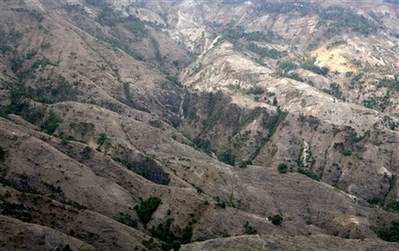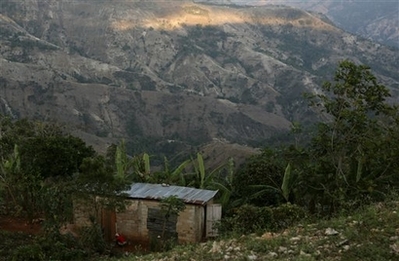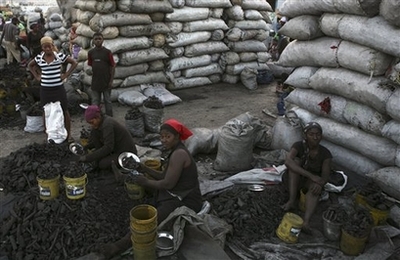| Want to send this page or a link to a
friend? Click on mail at the top of this window. |
Haiti's
Absolute Scarcity of Agricultural Land, Its Multiplying Effect, After Efforts to Halt
Deforestation Falter |
|
 |
| Deforested mountains are seen near Jacmel, in southern Haiti, Monday,
Jan. 28, 2008. Nearly all of the 30 million trees planted in the 1980's with a US$22.8
million project by the U.S. Agency for International Development, have been cut down to
make charcoal for cooking. Without trees to anchor the soil, erosion has reduced Haiti's
scarce agricultural land, making the island more vulnerable to devastating floods each
hurricane season.(AP Photo/Ariana Cubillos) |
GRAND COLLINE, Haiti: Far from the spreading slums of the Haitian capital, past barren
dirt mountains and hillsides stripped to a chalky white core, two woodcutters bring down a
towering oak tree in one of the few forested valleys left in the Caribbean country. Fanel
Cantave, 36, says he has little choice but to make his living in a way that is causing
environmental disaster in Haiti. And these days, he and his 15-year-old son, Phillipe,
must travel ever farther from their village to find trees to cut.
"There is no other way to get money," the father said, pushing his saw
through splintering wood that will earn him as much as US$12.50 (€8.50),
depending on how many planks it produces.
Such raw economics explain the disappearance of Haiti's forests. U.N. experts say just
2 to 4 percent of forest cover remains in Haiti. And despite millions invested in
reforestation, such efforts have mostly failed because of economic pressures and political
turmoil.
For example, the U.S. Agency for International Development embarked on an ambitious
$22.8 million project in the 1980s to plant some 30 million trees that could provide
income for peasants. But the project focused on trees that can be made into charcoal for
cooking, and nearly all were eventually cut down.
 |
| A shack sits on the hillside of a deforested mountain area near Jacmel,
in southern Haiti, Monday, Jan. 28, 2008. Nearly all of the 30 million trees planted in
the 1980's with a US$22.8 million project by the U.S. Agency for International
Development, have been cut down to make charcoal for cooking. Without trees to anchor the
soil, erosion has reduced Haiti's scarce agricultural land, making the island more
vulnerable to devastating floods each hurricane season.(AP Photo/Ariana Cubillos) |
Environmental Minister Jean-Marie Claude Germain said reforestation projects and
efforts to preserve trees in three protected zones were set back by the violent rebellion
that ousted President Jean-Bertrand Aristide in 2004 and prompted the U.N. to send in
thousands of peacekeepers to restore order.
"Even though there were agricultural laws, the laws were not respected,"
Germain said. "We are trying to create order now."
Stability returned with the 2006 election of President Rene Preval and U.N. military
action against Port-au-Prince's powerful gangs. But in a nation where 80 percent of the
8.7 million people live on less than US$2 (€1.35) a day, trees mean income for
those lucky enough to have access to them.
Some groups say they've found success on a limited scale by planting fruit trees and
protecting hardwoods through micro-loans and agricultural assistance. Floresta USA, based
in San Diego, California, has been working in Haiti for the last decade and is now
planting about 33,000 fruit and hardwood trees a year. The Organization for the
Rehabilitation of the Environment, based in southern Haiti, has produced more than a
million fruit trees since it began work in 1985.
Compared to the USAID's failed plan, smaller programs have had more luck by focusing on
fruit trees, which farmers are more likely to preserve to sell the fruit. And smaller
organizations are able to work with individual farmers and tailor planting to the needs of
specific areas.
"People aren't excited about, 'Hey let's go plant trees.' They're excited about,
'How can I feed my family? How can I make ends meet?'" said Scott Sabin, executive
director of Floresta.
 |
| Vendors sell vegetable charcoal at La Saline market in Port-au-Prince,
Wednesday, Feb. 13, 2008. Nearly all of the 30 million trees planted in the 1980's with a
US$22.8 million project by the U.S. Agency for International Development, have been cut
down to make charcoal for cooking. Without trees to anchor the soil, erosion has reduced
Haiti's scarce agricultural land, making the island more vulnerable to devastating floods
each hurricane season.(AP Photo/Ariana Cubillos) |
But many who are dedicated to restoring Haiti's forests have grown pessimistic. Despite
small successes, prospects are grim for implementing such programs on a grand scale.
"Everything has been studied and all the solutions are already known," said
Mousson Finnigan, the head of the Organization for the Rehabilitation of the Environment.
"But when it comes to implementation, it becomes a place where everybody's fighting
for the money. They're not fighting for results."
Christopher Columbus found dense tropical forests in 1492 when he arrived on the island
colonizers named Hispaniola, now shared by Haiti and the Dominican Republic.
But the trees began falling quickly, first as the Spanish and French cleared forests
for plantations and later as hardwoods were logged for U.S. and European markets. Peasants
then burned and cut down what was left in desperate search of farmland.
While the Dominican Republic still has some of the most impressive forests in the
Caribbean, parts of Haiti now resemble a moonscape of denuded mountains billowing dust.
Hillsides are blasted away to make bricks for the capital of Port-au-Prince.
Without trees to anchor the soil, erosion has reduced Haiti's scarce agricultural land,
making the island more vulnerable to devastating floods each hurricane season. More than
100 Haitians died in last year's floods, including dozens killed when a river jumped its
banks during a gentle but steady rain unrelated to any tropical system.
And in 2004, Tropical Storm Jeanne killed some 3,000 people in the coastal city of
Gonaives alone. And yet the trees keep falling. Orange fires can still be seen in the
hills above the capital as farmers clear land at night. At the La Saline market, charcoal
vendors arrive each day with mountains of bags, their faces coated with black dust.
"In Haiti we destroy instead of produce," acknowledges LeClaire Bocage, 38,
who sells 50-kilogram (110-pound) sacks for US$6.25 (€4.25). "They're going
to tell the poor to stop cutting down trees. But what will we do to make a living?"
It may be too late to restore Haiti's lost forests, said John Horton, an environmental
specialist who has overseen Haiti projects for the Washington-based Inter-American
Development Bank. He suggested planting crops that can stabilize the soil and be sold or
used for bio-fuels. Others promote raising money through carbon credits from overseas
firms emitting greenhouse gases elsewhere.
"They need cash crops, they need food, they need energy immediately," Horton
said.
___ Associated Press researcher Barbara Sambriski contributed to this story.
| Wehaitians.com, the scholarly journal of
democracy and human rights |


